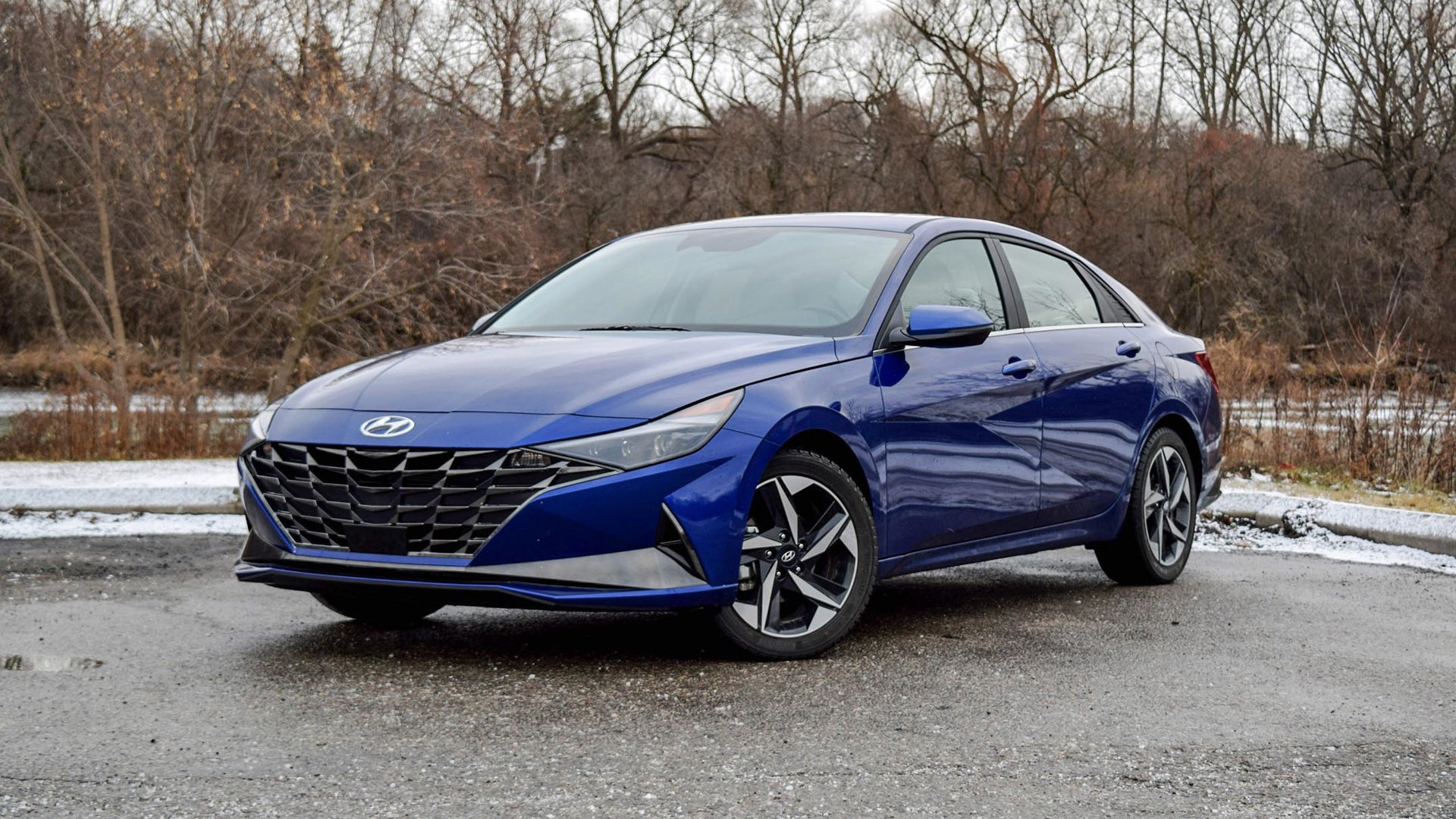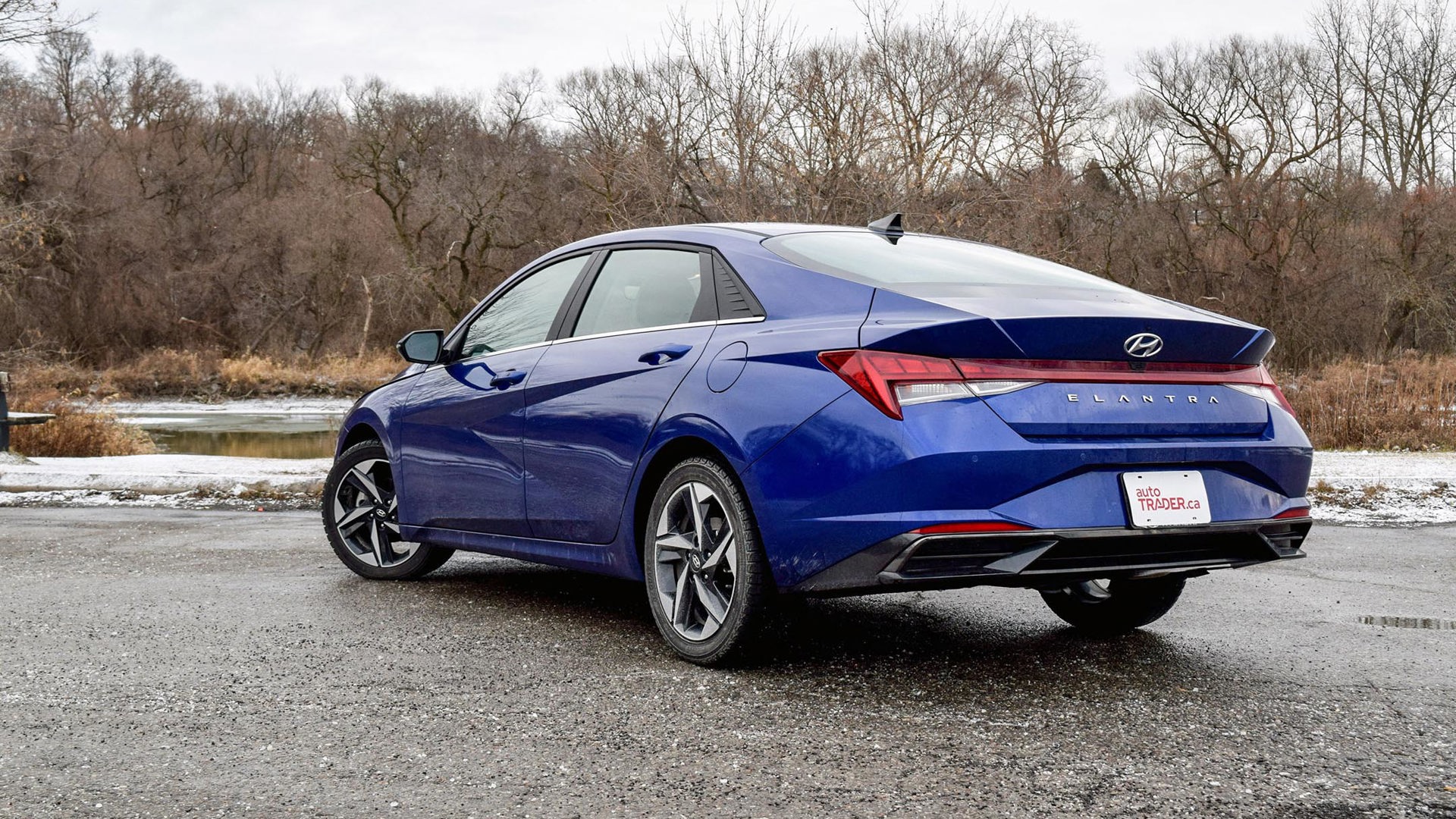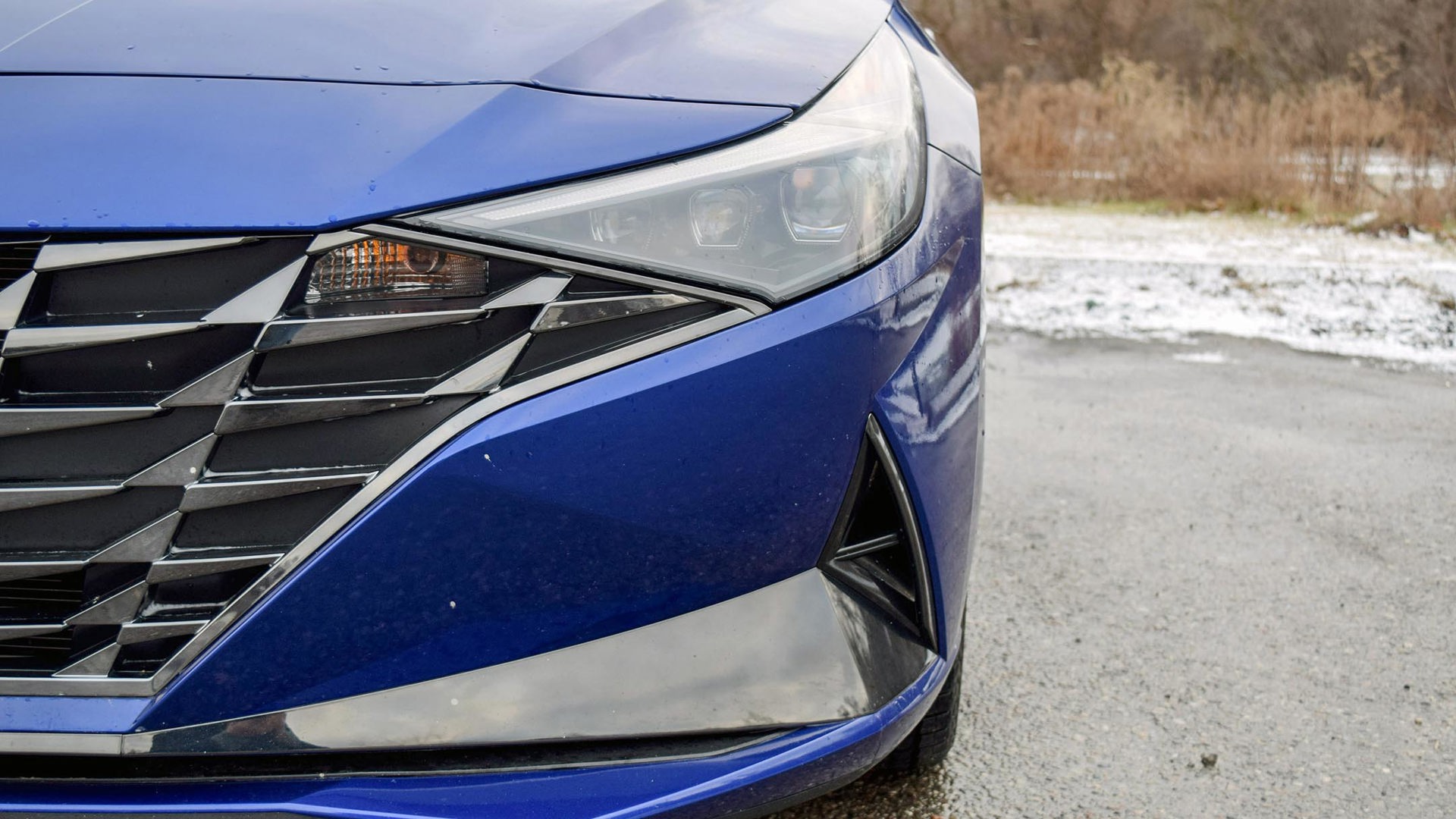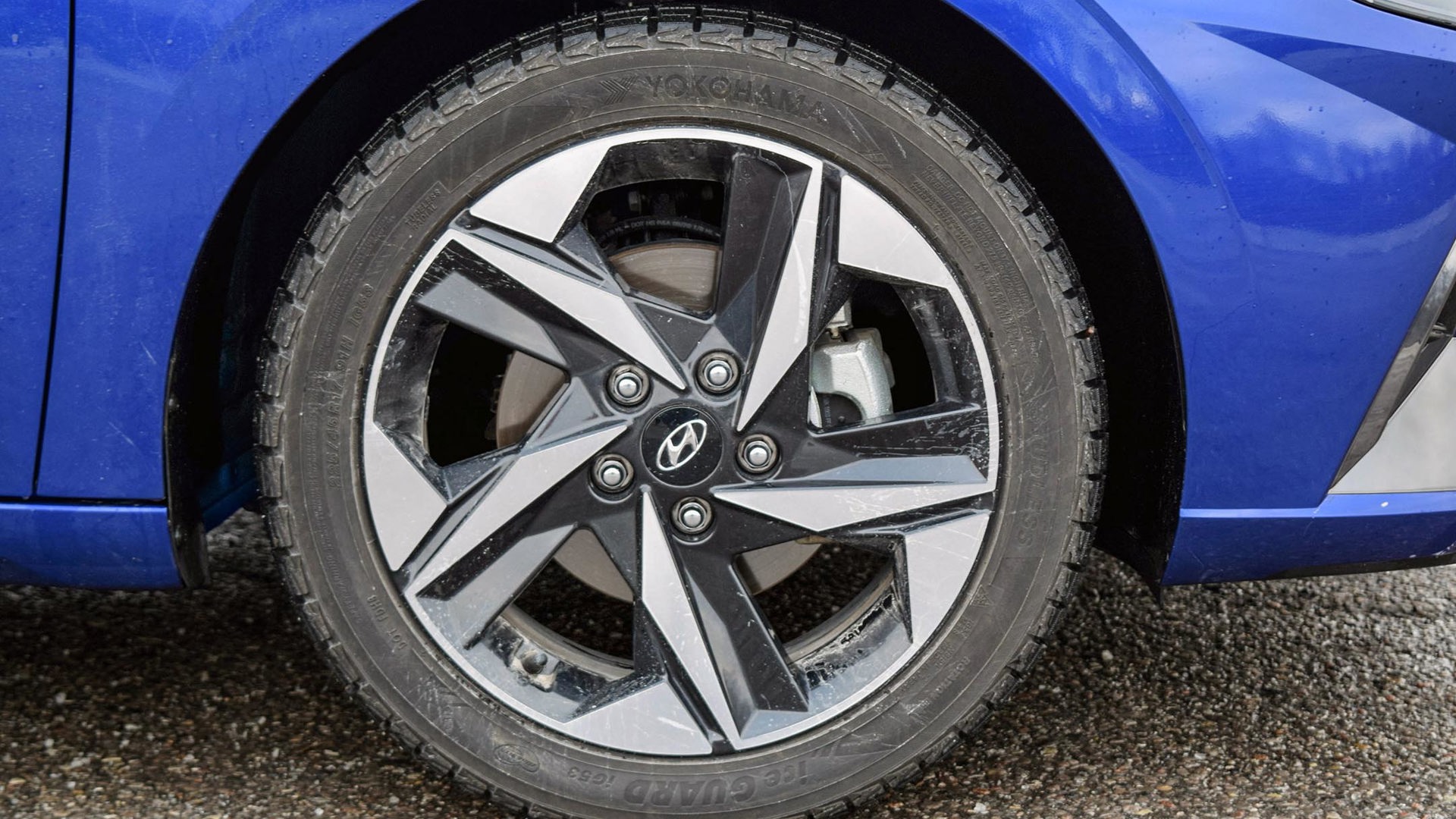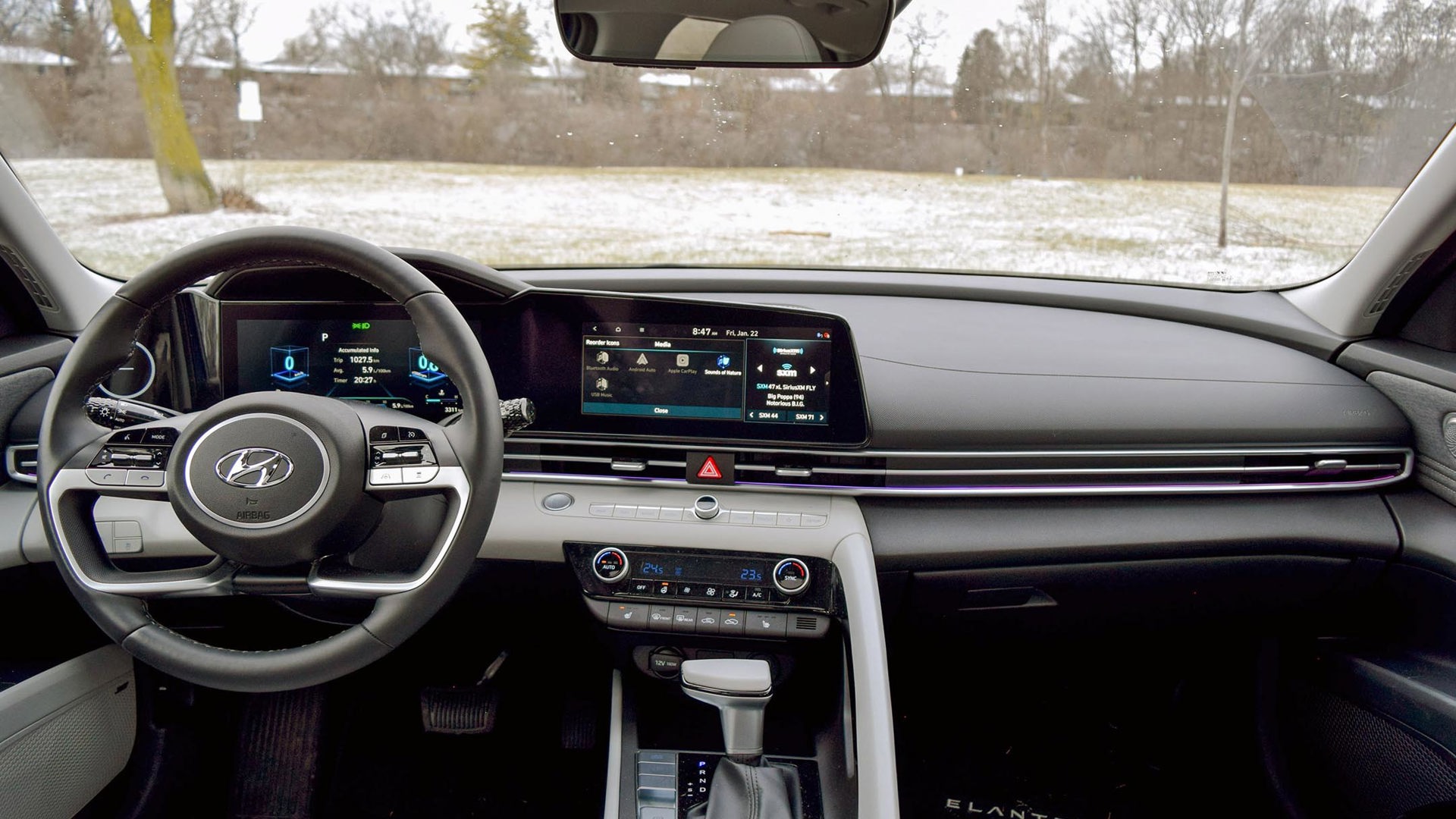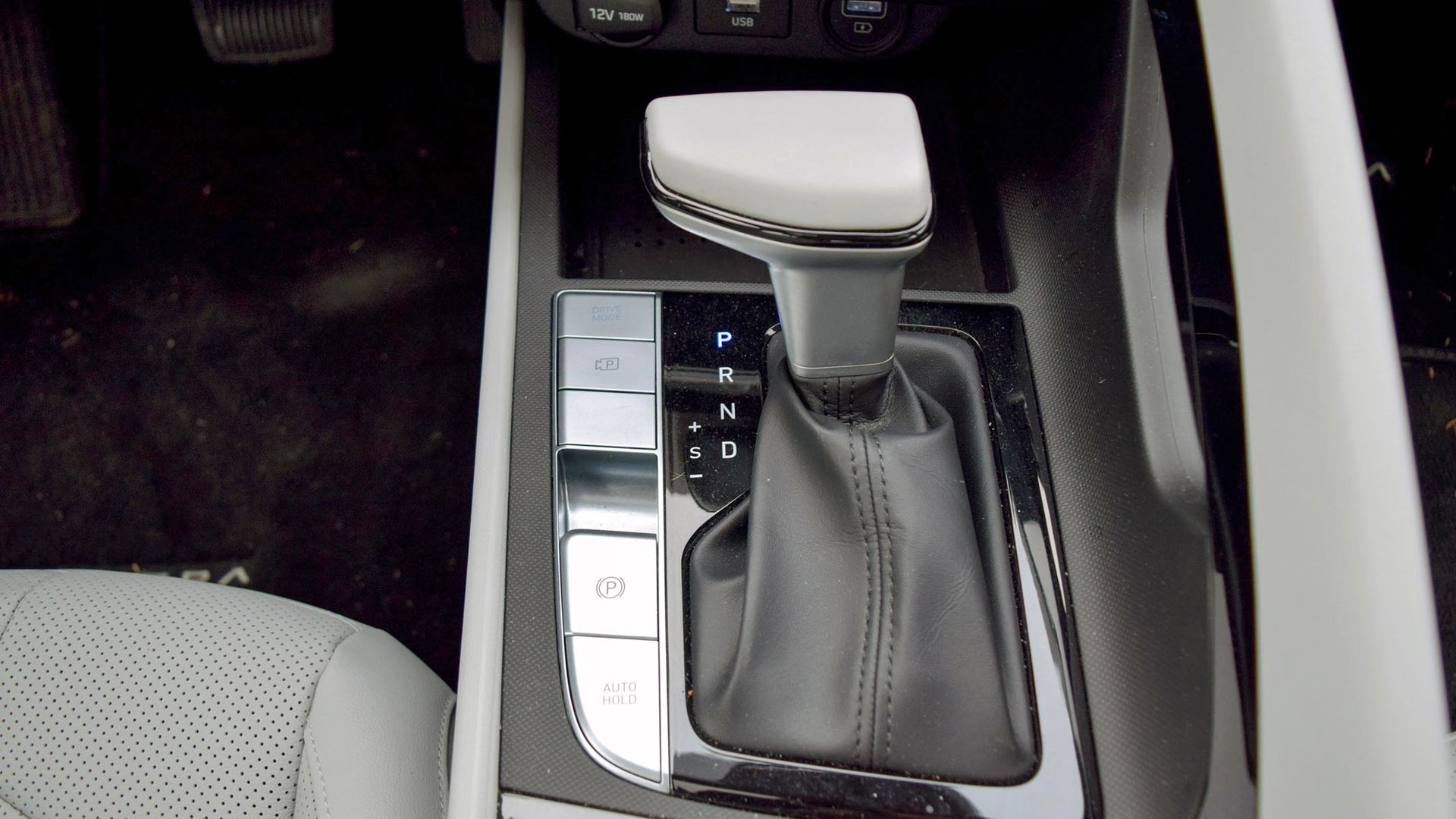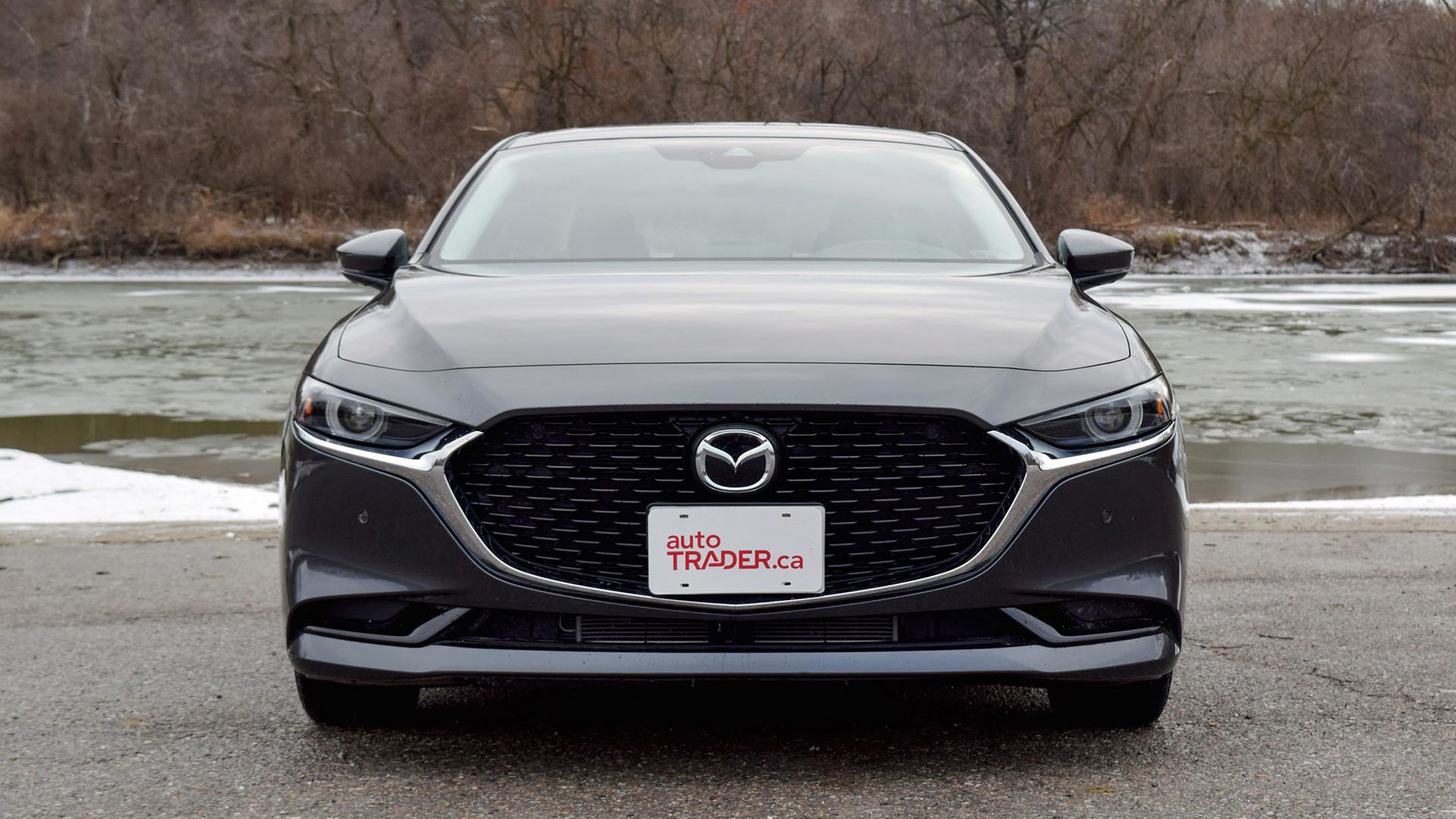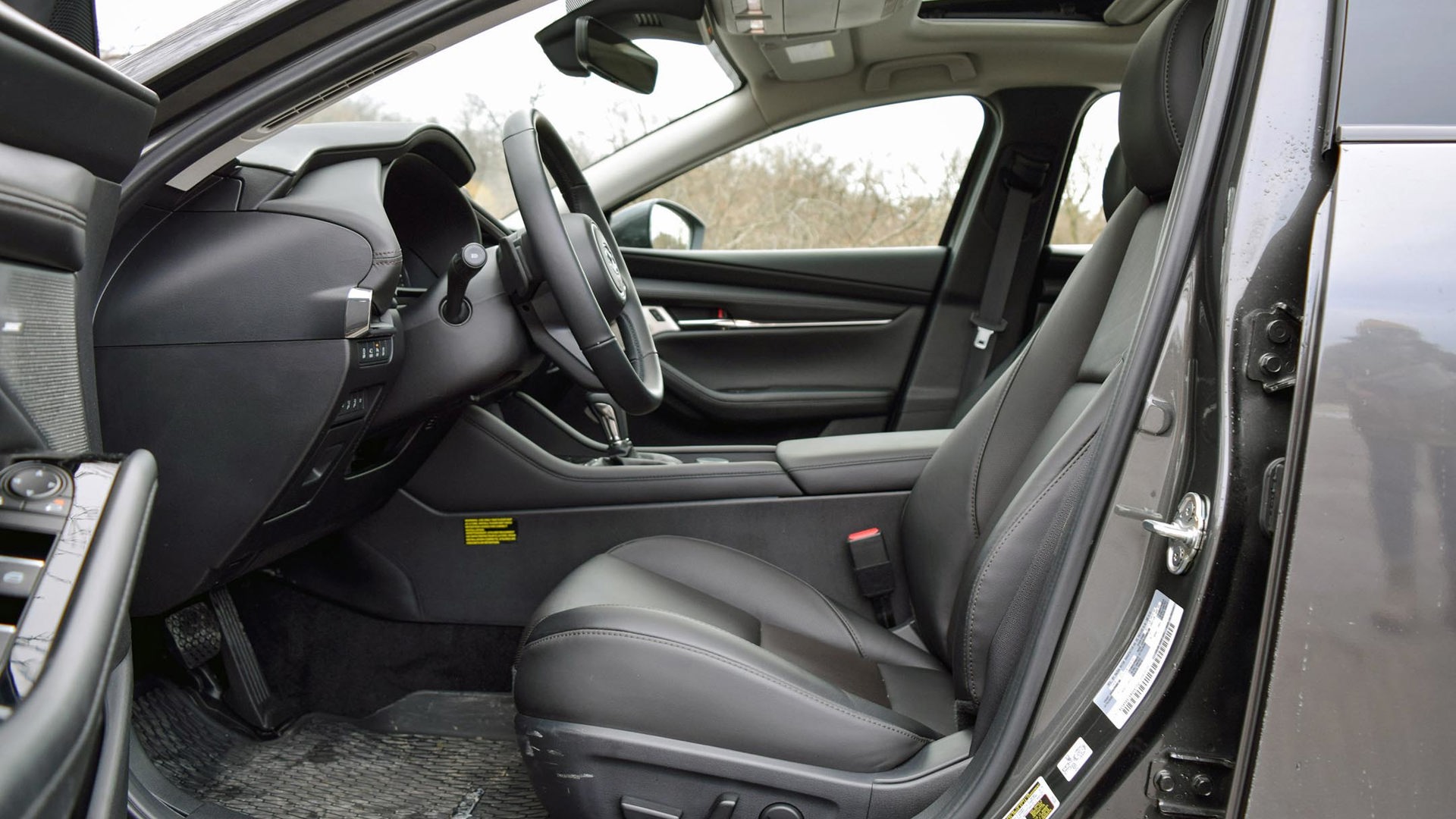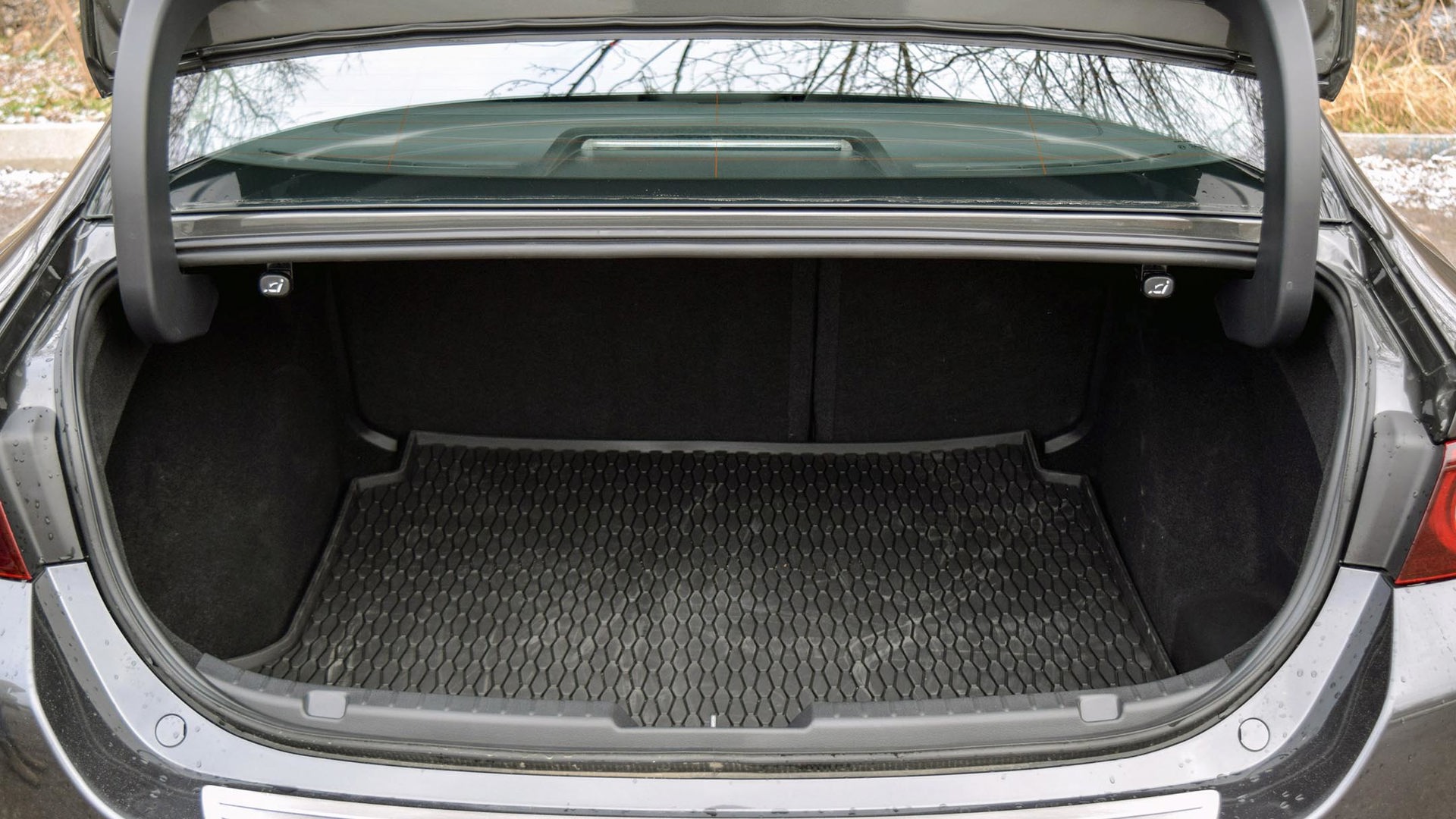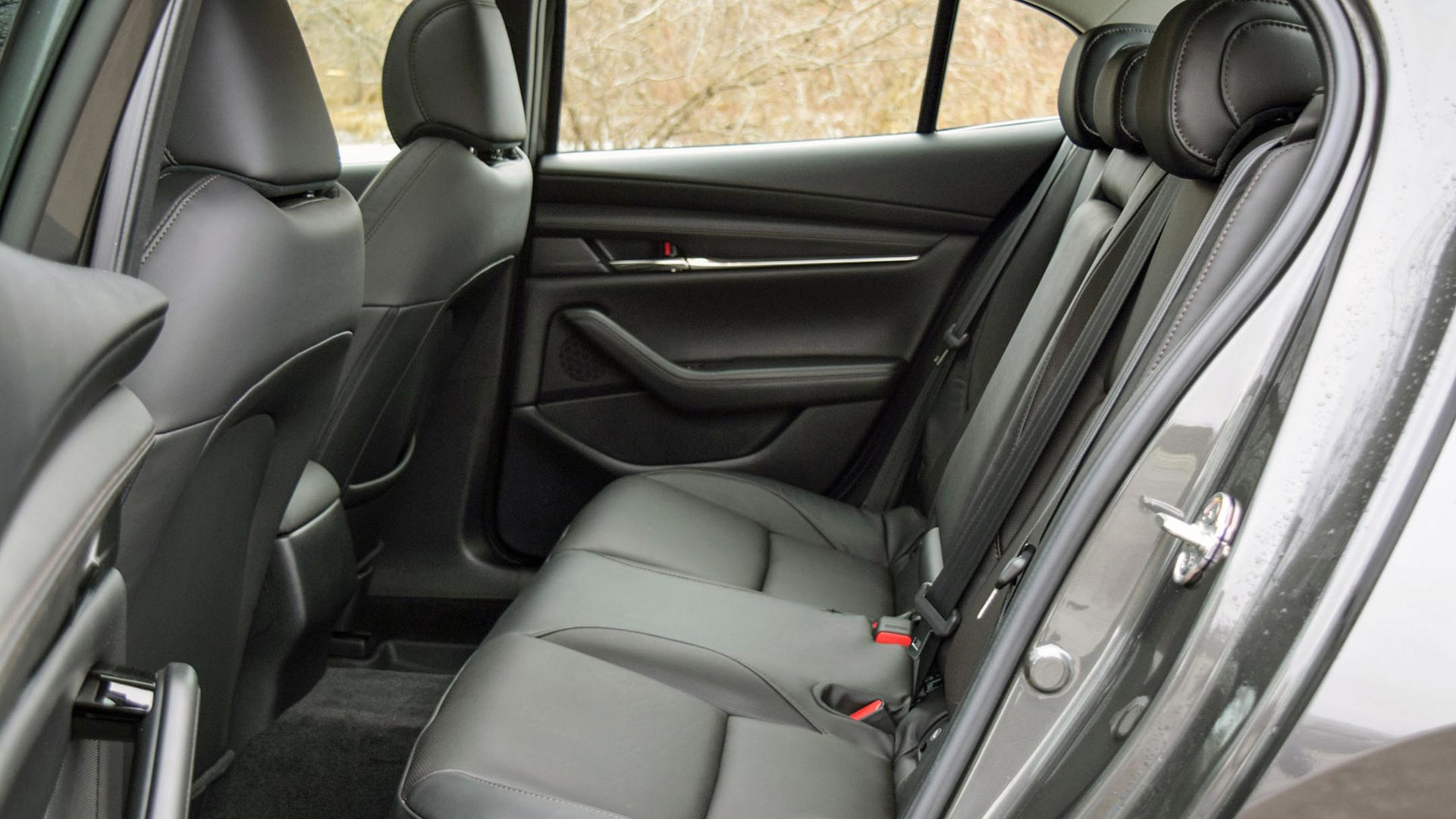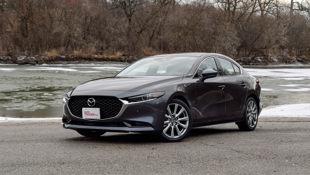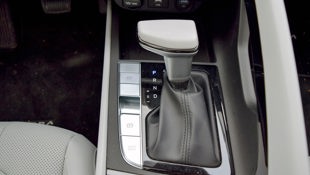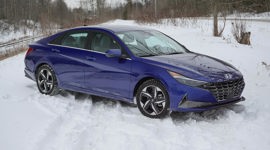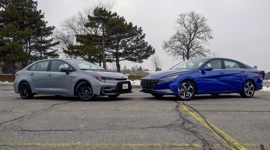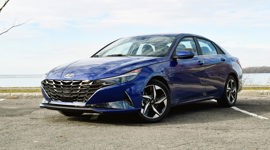Comparison Data
|
2021 Hyundai Elantra Ultimate
|
2021 Mazda3 GT AWD
|
|---|---|
|
Engine Displacement
2.0L
|
2.5L
|
|
Engine Cylinders
I4
|
I4
|
|
Peak Horsepower
147 hp
|
186 hp
|
|
Peak Torque
132 lb-ft
|
186 lb-ft
|
|
Fuel Economy
7.5 / 5.7 / 6.7 L/100 km cty/hwy/cmb
|
9.3 / 7.0 / 8.2 L/100 km cty/hwy/cmb
|
|
Cargo Space
402 L
|
374 L
|
|
Base Price
$25,599
|
$32,200
|
|
A/C Tax
$100
|
$100
|
|
Destination Fee
$1,725
|
$1,750
|
|
Price as Tested
$30,324
|
$34,050
|
|
Optional Equipment
$2,900 – Tech Package, $2,700; Paint, $200
|
None
|
There are so many crossovers on the market, but very few with distinct personalities and designs.
The same can’t be said about the current crop of compact sedans, which vary dramatically from one model to the next. Take the overhauled 2021 Hyundai Elantra, which features sharp creases, a busy grille, and tons of technology. Then there’s the 2021 Mazda3, a compact car with an elegant, premium design, and the surefooted confidence that comes with its optional all-wheel drive.
These two are perfect foils, representing some of the extremes in the compact segment. On top of that, both have relatively accessible price points and long lists of features, though some stand out from the rest.
Styling
The different approaches these two take is obvious at first glance. The Mazda3 has a certain elegance, with a sleek, uninterrupted body that exhibits shapely curves. The compact is alluring and mesmerizing in a way, especially as you see light reflecting off its profile. The exterior stumbles in a few places, however, as the C-pillar can look a bit bare, and the licence plate breaks up the flowing design in the front.
The compact Mazda further impresses with a cabin that channels a luxury brand. Details like knurled knobs, tactile controls, attractive speaker grilles, and a smartly integrated central gauge screen help the Mazda3 shine immediately. The seats and materials are top-notch, setting a benchmark for the class.
The redesigned Hyundai Elantra makes an equal attempt at catching eyes with its design, although its bodywork features plenty of lines and creases to draw attention. The car has a wide, patterned grille up front and slim headlights that provide an evocative style. The lightbar connecting the taillights is also a slick detail that adds to the design.
The Elantra’s cabin is much less cohesive than the Mazda’s but still impressive. A denim material adorns the door panels, but there are a few hard plastic surfaces found on the dashboard. Curiously, a large handlebar separates the front driver and passenger, breaking up the sense of unity between the two. While the Mazda3 exudes a premium feel through its materials and style, the Hyundai feels a bit more high-tech, with a large customizable digital dash and infotainment system.
Elantra: 8/10; Mazda3: 8/10
Safety
In 2021, it’s rare to see vehicles in highly competitive segments omit safety equipment like adaptive cruise control, forward collision warning, lane-keeping assistance, blind-spot monitoring, and rear cross-traffic alert. Naturally, these two vehicles pack the whole gamut.
However, they don’t arrive that way from their base levels. The basic Mazda3 GX only features standard blind-spot monitoring and rear cross-traffic alert; moving up to the GS, the next in line, adds the rest of those handy features, while the top-trim GT gets extra goodies like rear automatic braking, a surround-view camera, head-up display (HUD), and traffic-sign recognition. The 2021 Mazda3 was recognized by the Insurance Institute for Highway Safety (IIHS) as a Top Safety Pick+ winner, the top rating it awards.
The base Elantra Essential trim also lacks what many would deem essential safety features, but they are available on the mid-trim Preferred. The fully loaded Ultimate trim gets parking sensors and an intersection-oriented forward-collision warning system. Unfortunately, the IIHS hasn’t rated the Elantra yet.
Elantra: 8/10; Mazda3: 8/10
Features
While compact cars like these two are available at accessible price points, the base models lack a ton of truly appealing features. That’s not the case here, though, with lots of standard stuff throughout.
The Mazda3 comes standard with heated cloth seats up front, automatic headlights, rain-sensing wipers, push-button start, and an 8.8-inch infotainment system that features Android Auto and Apple CarPlay support. GS models add to those features with heated door mirrors, dual-zone climate control, a heated steering wheel, and a leather-wrapped shift knob. Fully loaded models get adaptive front lighting, memory seat and mirror adjustment, front and rear parking sensors, navigation, a 12-speaker sound system, and leather-trimmed seats, not to mention that cool HUD. Some of these features are included with a Premium package, adding more to the overall cost but extending the wow factor.
The Elantra also has plenty of standard equipment, including automatic headlights, heated side mirrors, heated front seats, and an eight-inch touchscreen infotainment system with Android Auto and Apple CarPlay. Mid-level Preferred trims get upgraded cloth upholstery, a leather-wrapped shifter, and a heated steering wheel. The top-level Ultimate model gets a sunroof, a wireless phone charger, leather seating, heated rear seats, an eight-speaker sound system, 10.25-inch infotainment system, digital gauge cluster, dual-zone climate control, and colourful ambient interior lighting. Like the Mazda, many of these features are only available through an additional package.
Elantra: 8.5/10; Mazda3: 8.5/10
User Friendliness
While the two cars are evenly matched, after spending some time in them the scale begins to shift. Using the Elantra’s controls and infotainment system feels natural and intuitive. The touchscreen is quick and responsive, while the USB port and wireless phone charger are easy to reach. The main concern that pops up while using the Elantra is the large handlebar that makes using the centre stack a bit of a headache for passengers. Also, the infotainment screen blocks off a quarter of the display when using Android Auto, which seems like a waste.
However, while the Mazda3 infotainment system seems simple and easy to use thanks to the rotary knob, it is almost too simple, lacking the quick and easy navigation options that are more accessible with a touchscreen. Rotating to dial a number, navigating through the map, or going back-and forth through menus to access radio presets all demonstrate the cumbersome feeling of the navigation system. Those seeking a bit more direct control should instead use the voice-recognition system, though that can feel a bit odd when others are in the car. This is a lowlight and contrasts with the rest of the controls, which feel tactile, responsive, and upscale.
Elantra: 8/10; Mazda3: 6.5/10
Practicality
The Mazda3 also stumbles a bit when it comes to space and practicality. The latest generation of the compact truly takes the segment name to heart, offering just 374 L of cargo room compared to 402 L in the Elantra. The rear-seat space in the Mazda is also cramped. Passengers in the rear will feel squeezed out with just 931 mm (36.7 in) of headroom and 891 mm (35.1 in) of legroom. The Elantra’s 947 mm (37.3 in) of headroom and 964 mm (38 in) of legroom in the back is far more accommodating.
Elantra: 7.5/10; Mazda3: 6.5/10
Comfort
With leather seating in both cars, it’s fair to say that the Mazda3 and Hyundai Elantra feature comfy thrones. Touchpoints like the armrests are plush in the Mazda, while Hyundai has a few rough and thinly padded panels. On the road, the ride in the Mazda is firm but not too harsh. As the rest of the car skews towards a premium experience, the ride is far from busy or engaging but smooth in how it handles uneven pavement, potholes, and other imperfections while motoring around. A small complaint is that the motor can sound a bit coarse and unrefined at times, and that soundtrack penetrates the cabin and will wear you out after a while.
The Elantra is a bit softer, leading it to be more comfortable on the everyday commute. It cushions changes on the road with ease, gliding from one destination to another. The Elantra has a loud cabin, too, and though the powertrain isn’t the most disappointing to hear, the wind and tire noise are more noticeable here.
Elantra: 7/10; Mazda3: 7.5/10
Power
Mazda offers three engines for its compact sedan. Base models get a 2.0L four-cylinder that’s rated for 155 hp and 150 lb-ft of torque. A 2.5L four-cylinder engine is available for the mid-trim GS and standard in the GT, and it packs 186 hp and 186 lb-ft of torque. The top-trim GT model can be equipped with a turbocharged 2.5L engine with an impressive peak of 250 hp and 320 lb-ft of torque. A six-speed transmission is matched with all available motors, though it varies from manual to automatic, depending on trim and engine. This tester was the non-turbo 2.5L with an automatic, the only transmission it comes paired to, and with optional all-wheel drive (AWD). That AWD system is a big bonus, even though it adds weight. Very few vehicles in this class have AWD, and those that do, lack the power and style the Mazda3 has. [Are you paying attention, Subaru? – Ed.]
A compact with 186 hp sounds like a blast, but in practice it feels like the Mazda3 is always lugging around in a gear too high for the given situation. Alternatively, using the sport mode makes the power from the engine far more accessible, but then the engine seems to be in too low of a gear, sometimes cruising on the highway in fourth. The only way to rectify this is to use the manual mode to swap gears with the gear selector or the paddles on the steering wheel. Of course, when tapping into all 186 hp, you’re also subjected to the rough-sounding motor, so it makes sense that Mazda hides it from you.
The Elantra sounds outgunned, as it features a 2.0L four-cylinder engine that makes just 147 hp and 132 lb-ft of torque. Thanks to a surprisingly responsive continuously variable transmission (CVT), however, the motor is well managed, and it never feels particularly sluggish or incapable of keeping up with traffic. Those seeking maximum performance will want to go for the Mazda3, or wait for one of the hotter variants of the Elantra like the upcoming N-Line model.
Elantra: 7.5/10; Mazda3: 8/10
Driving Feel
As a high-end-looking car with a pretty interior and extra power, I expected the Mazda3 to deliver a premium driving experience. For the most part, it matches the expectations, but there were a few concerns that were hard to reconcile. For example, the steering feels extremely heavy. It makes piloting this compact car feel like a chore, especially at low speeds like in parking lots. The groaning engine and oddly behaving transmission hurt the cause as well. The optional AWD system is a significant benefit here, though, as buyers net more confidence in inclement weather. While the ride is firm and direct, it all adds up to a very niche driving experience, which may not resonate with everyone.
The Elantra, on the other hand, drives with no personality. The steering is light, the throttle is responsive, and the CVT chimes in now and then to deliver some power before quieting down and getting out of the way. It lets you go on your way without much complaint or interference. Sure, the Elantra takes an extra tick to get settled in when performing quick lane-changes when compared to the smoother Mazda3, but it also feels a bit more eager to respond to your inputs, making it slightly more fun to drive.
Elantra: 7.5/10; Mazda3: 7/10
Fuel Economy
The fuel consumption of these two vehicles was a huge factor in picking an overall winner. The Mazda3, when equipped with this 2.5L engine, is expected to return 9.3 L/100 km in city driving conditions, 7.0 on the highway, and a combined 8.2 L/100 km. Our experience matched those ratings by Natural Resources Canada (NRCan). Our test loop, which included equal driving in dense city traffic and then on the highway, saw an average of 8.2 L/100 km.
The Elantra is rated to bring 7.5 L/100 km in city driving, 5.7, on the highway, and 6.7 combined, which is already a big difference from the Mazda3. Our experience saw it even more efficient than that, coming in at 6.3 L/100 km combined. These are near-hybrid levels of fuel economy and an easy win for the gas-powered Elantra.
Elantra: 9/10; Mazda3: 6.5/10
Value
Hyundai continues its success by offering a more affordable vehicle as well. The Elantra starts at $17,899 for the Essential trim and charges an extra $1,900 for the CVT. The mid-grade Preferred model is $21,899 and comes with the CVT as standard equipment. Buyers of this trim can also apply the Sun and Tech package for $1,500. The fully loaded Ultimate model starts at $25,599 and offers a $2,700 Tech pack. While Hyundai provides a white paint finish for no cost, it’s an extra $200 for any other colour. The unavoidable delivery and destination fees are $1,725, leaving our model with an asking price of $30,324.
The Mazda3 has a steeper asking price, with the base GX model starting at $20,500. That price is just for the front-wheel drive, six-speed manual model, so adding an automatic is an extra $1,300. The mid-trim GS model starts at $22,900 for a manual-equipped example, while automatic Mazda3 GS models are an extra $1,600. An upgraded GS model with AWD and a 2.5L engine has a total price of $26,500. The GT Model with front-wheel drive is $28,500 while the AWD model is $32,200. Those seeking extra power can opt for the turbocharged Mazda3 AWD which costs $32,900 and is offered with a $1,700 Premium package. All models are subject to the $1,750 freight fee, leaving our GT AWD tester with a pre-tax asking price of $34,050.
Elantra: 8.5/10; Mazda3: 7/10
The Verdict
While the Mazda3 does portray itself as a class above with a swanky cabin, high tech features like a HUD, and confidence-inspiring all-wheel traction, it also consumes way more fuel and will set you back a couple of thousand dollars when compared to the Hyundai Elantra. The latest Hyundai may not feel special, but it is more accommodating and more useful for the everyday commute. With its excellent fuel consumption and pricing, the Elantra should be the better fit for more buyers but it still manages to be modern through its in-cabin tech and attractive style.








